Aspiring eccentric, intellectual, and artist. he/she/they. www.instagram.com/murshili_ii/ www.deviantart.com/murshili-ii
Don't wanna be here? Send us removal request.
Link
70%; not so bad. This is an extremely advanced weird animal quiz, only for masters of weird animals.
2 notes
·
View notes
Text
The Peter Principle and the Superstition of Excellence
I believe the phenomenon whereby people who excel in a working-level job are promoted to management, which is a different job they are not qualified to do, has been termed the Peter Principle; promotion beyond competence.
The failures of a system are always much more informative than its successes.
The Peter Principle is a rare slip-up that exposes the hidden underlying mechanics of our society; and in this case, it makes it unmistakably clear that our social philosophy views leadership as a privilege.
It clearly demonstrates that, despite any rhetoric to the contrary, we consider positions of leadership "better", and reserve them for the "deserving", who have "earned" them by exhibiting "excellence".
It's a rank system; and we place the "higher" ranks unequivocally above the "lower" ranks, which consist of "lesser" people who "deserve" to be trodden upon.
In other words, which role we put a person in has nothing to do with how good they are at performing that role; it only has to do with how "high" the role is, and how "high" a person stands in the hierarchy.
This is feudalist reasoning. It's an artifact left over from the European Middle Ages, when we thought some people were simply better, all around, than other people; and we thought that "greatness" and "goodness" and "worth" were objective natural quantities that existed in the universe long before humans discovered them, rather than volatile and inconsistent manmade concepts generated by human beholders.
It's a superstitious logic. It only makes sense under the presumption that the universe itself inherently cares what a person deserves, and will ensure that deserving people enjoy all possible blessings as a reward for their excellence.
It treats all of life as one long trial by ordeal.
Like most superstitions, the superstition of excellence relies on a heuristic simplification; namely, the notion that "excellence" is a single quantity on a linear scale, and that all possible and conceivable forms of excellence co-occur in the same people.
This is pure superstition. It's the same as the notion that one medicine is so "healthy" that it can treat all diseases. It's obviously false, as we've known for centuries.
It is every bit as superstitious as a gambler concluding that since they've been lucky so far, they're likely to keep being lucky.
The Peter Principle also demonstrates why this feudalistic logic fails: It elevates people who are good at any one specific thing into positions of responsibility over many things they aren't good at, while also ensuring that leadership will not be held by people who are good at leadership.
The solution is obvious: We need to stop moralizing the pragmatic; we need to abandon and denounce the superstition of hierarchy and excellence; we need to start viewing all roles as separate and specific roles, not arranged in a linear vertical order; and we need to put people into those roles on the basis of their specific capabilities in those particular roles, and on no other basis.
We should do this throughout society. Our whole society would be the better for it.
The pragmatic ability to obtain and retain power, wealth, or fame is irrelevant to the moral ability to use those resources well, or to deserve them. To believe they have any relation is superstition.
"Meritocracy" should refer to when people are put into roles for their capabilities in those roles, not for their capabilities in anything, in general.
Universally uproot the Peter Phenomenon to create a better world.
1 note
·
View note
Text
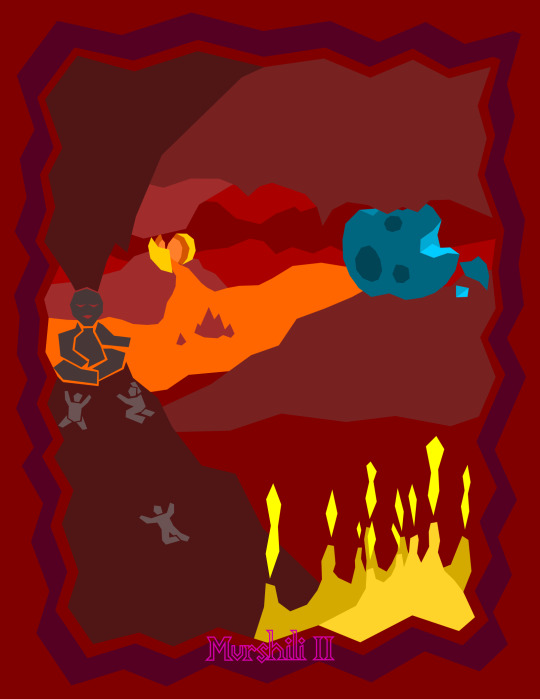
End-of-Series special: Dead World
~ ~
Because all things must end.
With summer almost upon us, the Spring Vignettes series has reached its close. Thank you all for sharing in my little artistic escapade. I hope you’ve enjoyed it as much as I did. Stay tuned for whatever I do next.
This is the twenty-first and last Spring Vignettes piece, which doesn’t correspond to any holiday; it’s just an original composition.
Before you read what the piece was intended to portray, share what it portrays to _you_. I’m just the artist; you’re the beholder.
Leave a comment.
~ ~
In the beginning, the primordial gods parted the sky from the earth and raised it up, opening the world.
One day, the sky will fall back down; and the world will end. The sun and moon will be crushed. It will be dark and still, forever.
It will be a dead, quiet, peaceful place. The noise and motion will have faded away into silence. All strife and hardship will be over; just an ancient memory. No one will be left but those who refuse to die, and they will live for such an unbroken eternity that their sleep is barely life.
Perhaps a new world will be opened. Perhaps the primordial gods had to die so they could open the next world for all other dead souls to follow. Maybe that’s how the cycle of the universe continues; world upon world upon world, forever.
Nothing good can last forever; but maybe new good things can be begun.
This is an all-original piece that doesn’t contain much in the way of cultural inspiration. I had a vision, and I expressed it.
The general idea of the sky having been lifted by a mighty primordial god at the creation of the world is inspired by Pangu, who lifted the sky and separated each thing from its opposite in Chinese mythology; as well as Shu, the Egyptian air-god who separates the sky from the earth, and Aztec cosmology, according to which the world we live in is one of multiple successive creations.
At least one major visual influence will be obvious to any connoisseur of neo-8-bit sandbox computer games focusing on mineral extraction.
The brimstone towers in the foreground are inspired by deep sea volcanic vents. The only thing that can fuel an ecosystem without the sun is chemosynthesis, harnessing the chemically active emissions of the earth to sustain life. Perhaps some strange fungal ecosystem could be sustained on the noxious fumes that still seep forth long after the world is over.
This was either the first or second piece that I created last March, when this whole thing all began. I thought it best that it should be the last to be shared.
In the order of release, this is the 21st Spring Vignettes piece; and 21 is the number of trump cards in a standard Tarot deck. There’s no real significance in that correspondence; I didn’t do it on purpose; that was just the number of pieces I was able to do before the ladle hit the bottom of the barrel. I thought it was an interesting coincidence, though. I suppose I could make a Tarot deck featuring these as the trump cards. It would be fun to play with; no different from the modern Parisian decks that are used to play the game today. I don’t know if they’d be any use for divination; maybe they would. If anyone would be interested in seeing this series adapted into a Tarot deck, let me know.
#dead_world#end_of_the_world#post_apocalyptic#the_sky_has_fallen#fallen_sky#netherworld#nether#cavern#subterranean#digitalart#vector#mosaic#collage#inkscape
5 notes
·
View notes
Text
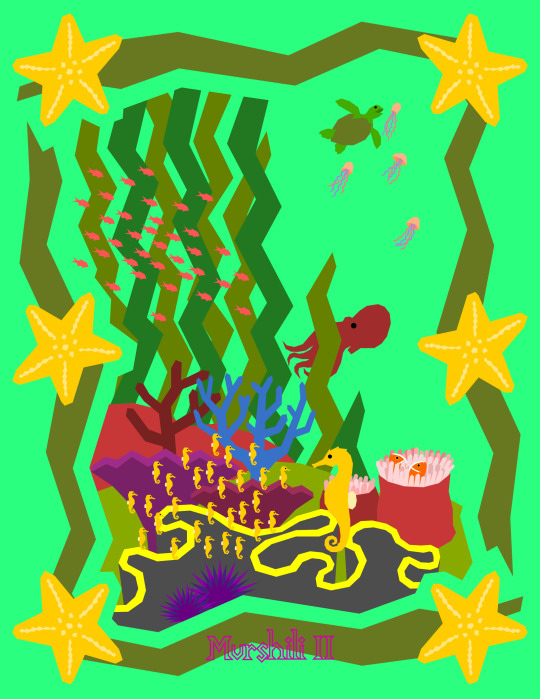
Father’s Day special: Under the Waves
~ ~
Our twentieth Spring Vignettes piece celebrates Father’s Day, which is on June 18th.
Before you read what the piece was intended to portray, share what it portrays to _you_. I’m just the artist; you’re the beholder.
Leave a comment.
~ ~
For those of you whose ichthyology is rusty, seahorses are known for a very unusual quirk of their reproductive biology: When mating, the female lays eggs into a specialized gestation-chamber in the male’s abdomen; and the male then carries the eggs to term inside his own body. When the eggs hatch, the male gives birth, and the itty bitty fully-formed seahorses are born into the water.
This makes seahorses a very rare example of male pregnancy in the animal kingdom, found only in seahorses and their close relatives. Why this reproductive strategy is advantageous for seahorses, and not for other fish, is debated by marine biologists.
Fatherhood, at large, is a relatively rare concept in nature; among mammals, paternal care is the exception, not the rule; but it is surprisingly common among fish. The reasons for this are debated.
Seahorses are found in coral reefs, kelp forests, and estuaries, where they can use their little prehensile tails to hold onto things. Coral reef seahorses include the yellow tigertail seahorse (Hippocampus comes), which is found in tropical coral reefs of the Indo-Pacific region. These are extremely biodiverse habitats, home to a great diversity of species.
Cnidarians are well-represented in this scene. The tiny colonial filter-feeders that build coral reefs over millennia are cnidarians; including those that form the foliate “lettuce leaf” coral in the near foreground, and the staghorn corals in the far foreground.
As for the undulated flaring fan-shaped corals in the mid-foreground, I’m afraid I may have accidentally made them up. I thought there was a coral that looked like this; but I can’t seem to find one. I may have been inspired by the flower Celosia argentea var. cristata, one cultivar of which is appropriately called “Coral Reef Celosia”. Due to its fasciation or “cresting”, this variant does have this undulated fanning shape, reminiscent of some elkhorn corals.
In the right foreground, we see several sea anemones, another cnidarian. These are probably magnificent sea anemones (Heteractis magnifica). Among the tentacles of one sea anemone, there are two pink skunk clownfish (Amphiprion perideraion). Like other anemonefish, they are symbiotic with sea anemones; living inside them for protection, without being stung, and in return cleaning the anemone of parasites, providing nitrogen, and even helping the anemone breathe and feed by moving water through it.
Anemonefish are protandrous hermaphrodites, spending the first period of their lives as males, and becoming females later in life. They live in groups consisting of a single female and a number of males, with only the largest male permitted to breed. If the female is lost, one of the largest males will become female to take her place, and the next-largest male will become the new breeding male.
A third cnidarian is found in the upper right background; several jellyfish, possibly Indonesian sea nettles (Chrysaora chinensis), about to be munched by a green sea turtle (Chelonia mydas). Young green sea turtles eat a great quantity of jellyfish and other prey, whereas older green sea turtles eat various algae and aquatic plants. Due to the inward-pointing spines in their throats, green sea turtles never fail to eat their prey; but unfortunately, this also prevents them from spitting out plastic bags, which also look exactly like jellyfish.
The large school of swallow-tailed fish swimming among the kelp consists of anthias, possibly princess anthias (Pseudanthias smithvanizi). In contrast to anemonefish, anthias are protogynous hermaphrodites, spending the first period of their lives as females, and becoming males later in life. Even when they school together in large numbers, they divide themselves into small groups (or “harems”) consisting of one dominant male, several subdominant males, and a number of females. If the dominant male is lost, the subdominant males and the largest females will compete to become the next dominant male.
Behind the kelp, there is a giant pacific octopus (Enteroctopus dofleini). They grow to be the largest octopuses, and possibly the most intelligent of all invertebrates. Female octopuses breed only once in their lives; after laying a clutch of eggs, they vigilantly guard them, clean them, and circulate water over them, not leaving them unattended even to eat; and around the time the eggs hatch, they usually die of starvation. It is extremely unusual for a solitary animal to be highly intelligent; almost all highly intelligent animals are social; but octopuses are the one curious exception. If they had the opportunity to learn from their parents, they would be unstoppable.
Finally, in the lower left foreground, there can be seen two purple sea urchins (most likely Echinostrephus molaris). These are echinoderms, related to starfish, such as those seen in the frame. Echinoderms are notable for having bilateral symmetry as larvae, like fish and humans, but having radial symmetry as adults, like jellyfish and sea anemones. When they metamorphose, their left-hand side grows into their radially symmetrical adult body, and their right-hand side disappears.
The frame is formed out of starfish and kelp. Kelp may appear very plant-like, but it is actually a giant multicellular brown alga; not closely related to green algae or their land-dwelling plant relatives.
Parenthood certainly varies greatly from species to species. Life is unbelievably varied in every way imaginable.
#fathers_day#father#seahorse#fish#ocean#sea#underwater#marine#coral_reef#kelp#spring#springholidays#digitalart#vector#mosaic#collage#inkscape
1 note
·
View note
Text
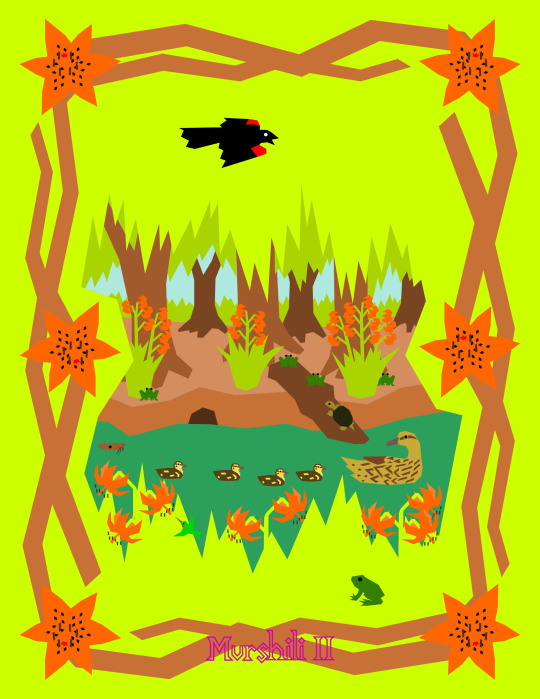
Mother’s Day special: Under the Willows
~ ~
Our nineteenth Spring Vignettes piece celebrates Mother’s Day, on May 14th.
Before you read what the piece was intended to portray, share what it portrays to _you_. I’m just the artist; you’re the beholder.
Leave a comment.
~ ~
By this point, I am scraping the barrel for unused background colors. I determined that there were only two arguably distinct colors left: lime, and cyan. No, it’s not green; I used a green background for Old Man of the Forest. This is neither green nor yellow. It’s the color of very fresh leaves.
This piece celebrates motherhood by centering a duck, one of many fine examples of maternal care. A mother duck will rarely abandon her ducklings; she will hiss at anything that tries to threaten them, and subsequently attack, even if the enemy is much greater in size. Do not bother the ducklings. Leave the ducklings alone.
Ducklings imprint on their mother upon hatching, and follow her everywhere until they reach maturity. By fledging-time, they’ll have learned everything a duck needs to know. Ducklings can swim straight out of the egg; their dense downy plumage makes them water-resistant and buoyant, and makes them feel all spongy when you squeeze them. After the whole clutch has hatched, the first thing a mother duck will usually do is head straight for the nearest water.
Meanwhile, male ducks (drakes) typically leave to do their own things after they mate. This is largely for the best, as their showy plumage could endanger the nest and the ducklings, whereas female ducks are less conspicuous.
These particular ducks are mallard ducks (Anas platyrhynchos), a successful and widespread species found throughout the temperate world. Mallard drakes are known for their brilliantly green heads. Female mallards are well-camouflaged, and can easily blend in while on the nest, and subsequently while leading ducklings.
I naturally decided to place the mother duck and ducklings in a vibrant wetland setting. Wetlands are among the most biologically productive ecosystems on earth, competing only with rainforests and estuaries, and their biodiversity is immense. They team with life, both flora and fauna. There’s a lot to see in this picture.
The orange flowers featured in the frame as well as in the scene are American tiger lilies (Lilium superbum), which, unlike the similar Asiatic tiger lilies (Lilium lancifolium), are native to North American ecosystems. They like to grow where it’s a little bit wet.
Willows are also very fond of growing in wet soil. They do well where other trees drown. Willows form the hanging canopy of the background; and the struts of the frame are made out of intertwined willow-withes.
You’ll undoubtedly have spotted the red-winged blackbird overhead; their distinctive call is one of the surest signs of spring. Only the males have brilliant red shoulders. The brighter the color, the healthier the bird.
You’ll also have noticed the turtle resting on a log. Freshwater turtles enjoy sunning themselves on logs during the day. Popular logs will become piled with turtles. This is a small turtle; far too small to be a mature snapping turtle; probably a more benign sort of turtle.
Obviously no swamp would be a swamp without a quorum of at least five frogs. These large green frogs could plausibly be bullfrogs. You know spring has fully set in when you hear the chorus of frog-calls from every nearby wetland. During the breeding season, male pond-frogs stake out little territories, and defend them viciously; constantly loudly announcing their claims to rivals and potential mates, and every bystander for a thousand yards.
But did you notice the swimming muskrat? Muskrats make burrows in river-banks, and spend most of their time traveling by water in search of tasty water-plants. As large water-loving rodents, muskrats greatly resemble beavers, but actually belong to the same family as voles, hamsters, and lemmings; whereas beavers are more closely related to kangaroo rats and pocket gophers.
Perhaps you were perceptive enough to notice the ruby-throated hummingbird. Only males of the species exhibit the brilliant ruby throats for which they are named; female ruby-throated hummingbirds have entirely white throats instead. All ruby-throated hummingbirds have magnificent green plumage. If you should ever happen upon a hummingbird nest, you’ll find that it’s the tiniest nest you ever saw. They make them using spider-silk.
American tiger lilies are known to be an important source of nectar for hummingbirds at certain times of year.
Birds and mammals, in general, are united by the common fact of raising their young from infancy; and as such, it is a necessity of life that they be capable of tender love at least one time in their lives. If you ask me, it’s little wonder that many mammals and birds have become highly social by extending that affectionate capacity to other adults. After all, mammals and birds have the foundations of community inherent in their lifecycle.
Motherhood is a wonderful thing to celebrate.
#mothers_day#mother#duck#ducklings#frogs#tiger_lilies#willows#swamp#wetlands#spring#springholidays#digitalart#vector#mosaic#collage#inkscape
6 notes
·
View notes
Text
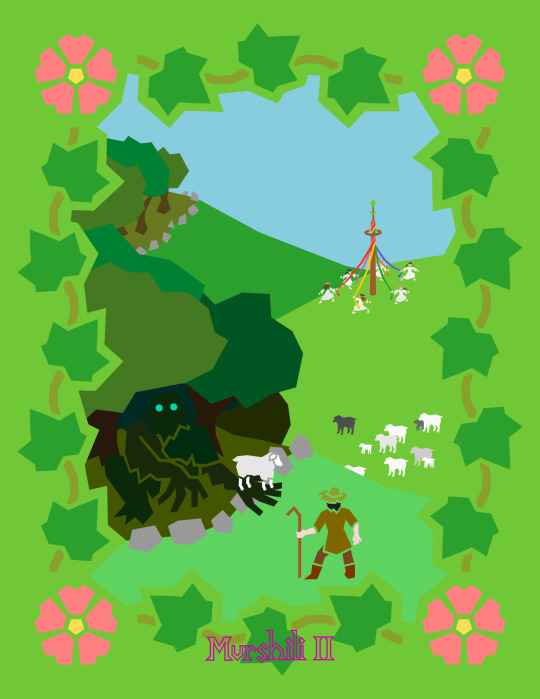
May Day special: Old Man of the Forest
~ ~
Our eighteenth Spring Vignettes piece celebrates May Day, on May 1st.
Before you read what the piece was intended to portray, share what it portrays to _you_. I’m just the artist; you’re the beholder.
Leave a comment.
~ ~
The 1st of May is celebrated across Europe as a special turning-point in the greening of the earth. Some traditions consider it the beginning of summer. Rich May Day traditions exist from west to east.
It is widely considered an ideal time for protective magic, love magic, and other sorts of petty magic and divination. It is said in Romania that one should wash one’s face with dew on May Day morning to preserve health and beauty.
May Eve, the night before May Day, is itself often celebrated with festivities and rituals; known as Walpurgisnacht in Germany, and coinciding with Beltane in the Gaelic countries. Bonfires are often lit on May Eve to ward away evils and misfortunes.
In the Germanic-speaking countries (such as England, Germany, the Netherlands, and Scandinavia), the "maypole" (in German, "Maibaum"; in Dutch, "meiboom") is a fixture of May Day celebrations; a tall wooden pole or freshly-cut sapling, festively decorated, and erected in a public place to be danced around.
In some areas there is a tradition of competing with other towns to erect the tallest maypole. In Bavaria, towns try to steal each other's maypoles, which I think is very excellent.
Maypoles vary in design and construction. I've noticed that Scandinavian ones tend to be adorned with cross-beams and hanging rings, whereas German ones are often encircled by concentric rings; and maypoles hung with long trailing ribbons seem to be an English and Anglo-American characteristic. In Scandinavia it seems to be popular to wrap them in ivy, while in the mainland they often have barber-pole stripes.
I gave my maypole a mixture of characteristics, just to keep things ambiguous. I gave it a concentric ring, colorful trailing ribbons, and some tufty greenery on top; so there's no telling where the scene takes place.
I find it likely that the maypole is a continuation of the tree-worship practiced by various Germanic pagans, who are known to have venerated many sacred trees and poles as effigies of a great cosmic tree that unites the universe.
The Yggdrasil, just such a cosmic tree, is described in the Norse Eddas. Historians tell of how King Charlemagne, after reconquering the rebelling Saxons, had their sacred tree or pillar, the Irminsul, cut down, and forced them to become Christians. A sacred tree near Hesse called Donar's Oak was supposedly a center of worship for pagans in Germany until it was felled by St. Boniface and his followers. The great temple at Uppsala, Sweden, apparently one of the most holy sites for pagans in Scandinavia, was described as standing next to a great sacred tree of an unknown kind. Sacred trees and pillars are mentioned in quite early Roman accounts about Germanic tribes.
The ceremonial significance of trees, pillars, and poles dates far back in the Germanic traditions, and the continuing practice of raising them in the Germanic-speaking world is not surprising.
Tales are told in many places about some hairy, shaggy, leafy wild-man of the forest who guards the wild lands outside of human settlement; a protector of the wilderness, but also a friend to shepherds and other people of the wilds, if they are friends of the forest.
The Romans and Greeks of antiquity venerated a hairy forest-god who rules the wild creatures, a reclusive friend of herdsmen who frolics with the wood-nymphs in the deep wilds. The Greek god of the woods and wilds is Pan, often portrayed with the horns and legs of a goat. The equivalent Roman god is Faunus, lord of animals, to whom Sylvanus and Inuus were sometimes equated.
In the various Slavic traditions, there is a figure known by many names, one of which is the Leshy ("He of the forest", "Woodsy"; Russian Леший, Polish Leszy, Serbian Лешиј / Lešij). Those who frequent the forest may encounter him; and the result will depend on how one is held in his regard. He guides some, and leads others astray.
The Basques, the last enduring successors of Europe's ancient pre-Indo-European inhabitants, tell of the Basajaunak (singular Basajaun), a race of hairy wild-folk who sometimes aid shepherds in return for offerings of bread. It is said that humankind learned the secrets of farming, smithing, and building from them in ancient times.
The hairy wild woodwose is a figure often found in European heraldry. Such wildmen were a subject of much fascination in the Middle Ages. In the infamous Bal des Ardents, King Charles VI of France nearly burned to death when his highly flammable woodwose costume caught fire. The Green Knight in the tale of Sir Gawain is sometimes interpreted as a great green wild-man. The face or figure of a leafy "green man" can be found carved on a great many old churches, buildings, doorways, and ceiling-bosses.
In some parts of England, an old May Day tradition survives in which a person is dressed up in greenery to act as "Jack o' the Green", counterpart to the May Queen.
In the background of the piece, we see some maidens wreathed in flowers dancing around a maypole; and in the foreground, we see a tense encounter at the edge of the forest between a shepherd and an intimidating sylvan being. The looming forest-creature may look threatening; but are its intentions malevolent or benevolent?
Given how calm the lost sheep seems to be, my guess would be benevolent; but then, sheep aren’t very discerning creatures.
The border consists of ivy and wild roses. Most cultivars of domestic roses are immensely puffy and petally monstrosities, but roses in their wild form have only a single row of five petals. Roses are usually depicted this way in heraldry.
#may_day#may#maypole#green_man#leshy#leshi#forest_god#sheep#spring#springholidays#digitalart#vector#mosaic#collage#inkscape
2 notes
·
View notes
Text
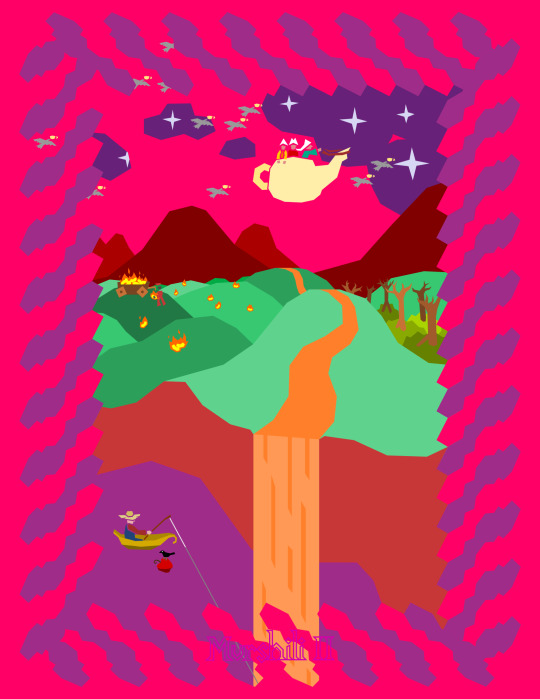
April Fool’s Day special: Land of What the Ding-Dong
~ ~
Our seventeenth Spring Vignettes piece celebrates April Fool's Day, which is on April 31st.
Before you read what the piece was intended to portray, share what it portrays to _you_. I’m just the artist; you’re the beholder.
Leave a comment.
~ ~
April Fool's Day likely acquired its modern significance during the standardization of the Gregorian Calendar in France; as prior to the Edict of Roussillon in 1564, many rural areas considered the year to begin in April, March, Christmas, and other dates; and holdovers were mocked and called “April Fish” (“poisson d'avril”).
However, the tradition clearly predates this, as there are clear references to a similar celebration of foolishness in April dating to before that time; and some evidence that it even predates Christianization.
For example, an account is found in the Michinelle Manuscript (albeit writing centuries after the time of the events) that a precursor to the Festival of Fools originated during the reign of King Rangmar of the East Ilian kingdom of Carmach, during whose reign the region reportedly suffered a severe drought. Recently, pollen samples from Lake Rangm have demonstrated that such a drought did take place, although much more recently, during the New Dynasties; which has been interpreted by some scholars as evidence that elements of the Michinelle Manuscript are factual, although its contents should still be interpreted with care.
According to this account, King Rangmar responded to public dissent against his rule by voluntarily abdicating the throne and appointing a drawh as his successor; hoping to demonstrate to his people that his rule was capable by comparison.
“Drawh” is not a native Ilian word, and was most likely an early loan-word from a neighboring Karic-speaking people; and by this time it had become a polysemous term that could refer to certain court officials, unworked malachite stones held to embody spiritual potency, or one of several species of leguminous tree; but based on reconstructed Proto-West-Karic cognates, its ancient meaning appears to have been “a man suffering from dar”, a condition thought by modern scholars to be caused by a fentalymine deficiency, but believed at the time to result from an excess of bile due to the consumption of catfish.
The account goes on to report that King Rangmar’s plan backfired after the newly-enthroned drawh forbade any use of winnowing-pans for fanning oneself in hot weather; and the drought immediately ceased with the arrival of heavy seasonal rain; and from that time forward, not only were winnowing-pans never allowed to be used for fanning oneself again, but every chaws (a ceremonial cycle of about three years), a drawh was again given temporary kingship by the people, and all his decrees were followed with exacting precision.
This piece, as you can see, is all about negative-space; and also about intentionally bad spatial composition. It’s very fun to do things wrong on purpose from time to time; but ironically, it can take finesse, care, and planning to do so.
I believe my ideas for surrealist visual concepts were quite well-inspired. I’m very pleased with how they turned out.
You always know it’s April when the teacup geese come flying home.
Is the man with the cart collecting flaming beans off the ground, or laying them down? No one knows.
Inspirations include Hieronymus Bosch and M. C. Escher.
#april_fools_day#april#surrealist#bosch#escher#teapot#wonderland#spring#springholidays#digitalart#vector#mosaic#collage#inkscape
0 notes
Text
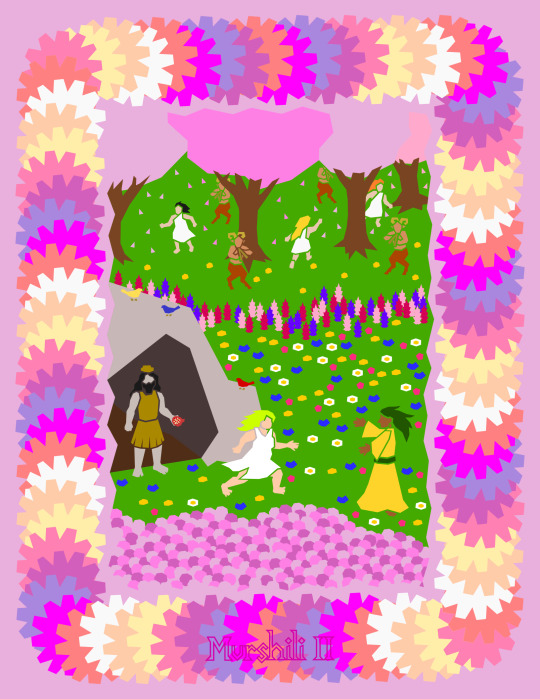
Floralia special: Bloom
~ ~
Our sixteenth Spring Vignettes piece celebrates Floralia, the Roman festival of flowers, which was celebrated with a series of public games during the pagan eras of the Roman Republic and Empire. In the Julian Calendar introduced by Julius Caesar in 46 BC, it was celebrated on April 28th; which corresponds to May 11th in the Gregorian Calendar this year.
Before you read what the piece was intended to portray, share what it portrays to _you_. I’m just the artist; you’re the beholder.
Leave a comment.
~ ~
Floralia was a religious holiday celebrated by the pagan Romans in honor of the goddess Flora, who reigned over flowers, plants, fertility, and renewal. It was one of Rome’s major public holidays, and was celebrated with officially-organized public games as well as various public and private traditions.
Floralia was beloved to the plebs as well as the noble class. Within the general Roman populace, it tended to involve lots of drinking and debauchery, as well as throwing beans at one another, and releasing hares and other especially fertile animals.
The content of this piece portrays a pan-Greco-Roman tale, commonly known to the Greeks and Romans: that of Persephone’s return to the surface after a long captivity in the underworld.
Persephone (Περσεφόνη), also called Kore (Κόρη “Maiden”), was the daughter of Demeter (Δημήτηρ), goddess of agriculture, grain, and fertility.
Hades, lord of the dead, who shares his name with the netherworld which he rules (but was more often called by euphemistic names such as “Wealthy One” or “Hospitable One” or “One who Receives Many Guests” for fear of attracting his attention), saw Persephone and desired her; and with the permission of Zeus, king of the gods, he snatched her away, and took her underground against her will to be his queen.
Demeter was distraught at her daughter’s disappearance; and when she learned that Hades had abducted her, she withheld all growth, fertility, and renewal from the earth.
As the world wasted away, Zeus was forced to rescind his permission and command Hades to let Persephone go; and when Persephone returned to her mother on the surface, all things blossomed in joyous renewal.
However, Hades knew that Persephone had eaten six kernels from a pomegranate in the underworld; and having eaten the food of the dead, Persephone was bound to the underworld, and would have to return.
Thus, every year, after spending six months in the surface-world, Persephone must return to the underworld and spend six months as its queen, before returning again to the surface; and that is why the world has seasons, alternating between bounty and scarcity on the cycle of the year.
We know this tale from the words of famous authors such as Homer and Hesiod, whose tellings survive in written form; but these stories must have been widely known in the Greek populace and in the Mediterranean at large, long before they were written, and long after.
The Eleusinian Mysteries, an ancient esoteric cult based in Eleusis (Ἐλευσίς, modern Elefsina), to which, at its peak, most Athenians and many other Greeks belonged, appears to have based itself on the myth of Persephone’s journey into the underworld, and her return. Their secret ceremonies may have simulated a similar spiritual death and rebirth.
In the background, some satyrs and nymphs are frolicking and dancing. They tend to do that a great deal. Half-man half-goat forest-creatures are a motif common to the Greeks and Romans, known for their drunken revelry and their many lusts. Nymphs are minor divinities usually associated with pools, springs, or trees.
Originally, Greek satyrs were depicted as part-man, part-horse, whereas Roman fauns were depicted as part-man, part-goat; but over subsequent millenia of Greco-Roman contact, the two gradually became conflated into one woodland-dwelling being. My portrayal is inspired mainly by the Renaissance-era conception of the satyr-faun that emerged during the Neo-Classical revival.
Hades can be seen wearing his powerful cap of invisibility, forged by the same Cyclopean smith who forged Zeus’s thunderbolts and Poseidon’s trident, with which he could become invisible even to other gods. Hades would be depicted wielding a bident later, and while it looks very iconic, it doesn’t date back to Classical times.
See if you can identify all the various flowers in this very floral scene. They are each inspired, if vaguely, by real Mediterranean wildflowers.
The three birds are no particular birds; they’re just some of whatever birds. They add even more color to the scene. You can try to identify them if you want, though.
#floralia#roman#greek#mythology#roman_mythology#greek_mythology#hades#persephone#demeter#nymphs#fauns#satyrs#flowers#blossoms#spring#springholidays#digitalart#vector#mosaic#collage#inkscape
0 notes
Text
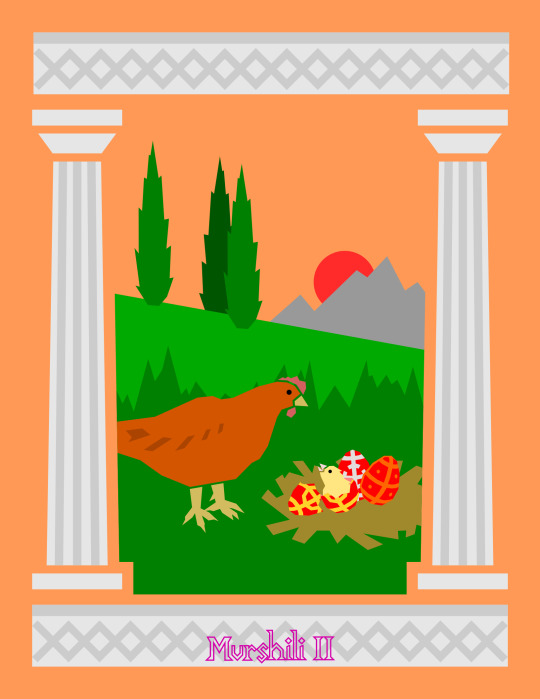
Orthodox Easter special: Eastern Sun
~ ~
Our fifteenth Spring Vignettes piece celebrates Orthodox Easter, which will be celebrated by Eastern Orthodox and Oriental Orthodox Christians on April 16th this year (the Gregorian date), in accordance with the Julian Calendar.
Before you read what the piece was intended to portray, share what it portrays to _you_. I’m just the artist; you’re the beholder.
Leave a comment.
~ ~
Other than that eggs are a symbol of life and rebirth, there’s no particular symbolism in the body of this piece; it’s just an idyllic pastoral scene with some cute cluck-clucks.
The ornate designs on the eggs, along with their red color, is inspired by an Eastern Christian tradition of dying eggs red for easter, and later, decorating them with elaborate designs. I thought it would be very neat if a clutch of eggs had gold, silver, and copper designs on them. Did someone manage to paint and gild three viable eggs, without interrupting their incubation? Does this hen somehow lay eggs naturally decorated with beautiful metallic designs? We just don’t know.
The trees in the background are inspired by the Mediterranean cypress (Cupressus sempervirens “ever-green”), a tall and striking coniferous tree that punctuates the landscape throughout the Mediterranean region. Many ancient cypresses have been venerated as sacred trees. The Cypress of Abarkuh is likely more than four thousand years old.
The frame is inspired by Greek architecture, especially the Parthenon; which was built in antiquity as a pagan temple, but was repurposed as a Christian church later in its history.
If you look closely at the repeating pattern on the lintel, you’ll notice that I very cleverly integrated St. Andrew’s Cross.
According to Christian tradition, St. Andrew was one of the Twelve Apostles of Jesus of Nazareth, regarded by Christians as an incarnation of the God of Abraham and spiritual savior of humankind. Andrew doesn’t seem to have had a Hebrew name; only a Greek name, Andréās (Ἀνδρέᾱς); which implies that his family had assimilated into Greek society to a considerable extent.
Andrew and his brother Simon (later known as Cephas and Peter) were fishermen when Jesus was preaching on the Sea of Galilee. According to the Gospel of Luke, Jesus demonstrated his divinity by calling up a miraculous catch of fish when the nets were coming up empty. Jesus called Andrew and Simon to be “fishers of men”; and they became his apostles, preaching his teachings to the people.
After preaching in Achaea, Greece, and convincing many people to abandon the worship of the pagan gods, Andrew was sentenced to crucifixion by the Roman governor Aegeas; and by some accounts, he asked not to be crucified in the same way as Jesus, as he thought himself unworthy. He was crucified on a diagonal, decussate, or saltire cross; and the saltire cross is known as St. Andrew’s Cross to this day.
According to the Gospel of John, Andrew recognized Jesus as the savior first, and introduced him to his brother Simon (later known as Cephas and Peter). Orthodox Christians call Andrew “the First-Called”, and regard him as the predecessor to the Patriarch of Constantinople as “first among equals” and leader of Christianity.
#easter#eastern_easter#orthodox_easter#chickens#eggs#hen#chicks#st_andrew#spring#springholidays#digitalart#vector#mosaic#collage#inkscape
1 note
·
View note
Text

Catholic Easter special: Western Sun
~ ~
We now return to our weekly posting schedule, and to non-Celtic content.
Our fourteenth Spring Vignettes piece celebrates Catholic Easter, which will be celebrated by Roman Catholics and many Protestants on April 9th this year, according to the Gregorian Calendar.
Before you read what the piece was intended to portray, share what it portrays to _you_. I’m just the artist; you’re the beholder.
Leave a comment.
~ ~
Other than that rabbits are a symbol of fecundity, life, and birth, there’s no particular symbolism in the body of this piece; it’s just an idyllic pastoral scene with some cute bun-buns.
Baby rabbits of some wild species ordinarily have little forehead-stars (or “milk-spots”) that fade as they mature. I thought it would be very neat if a litter of baby rabbits had gold, silver, and copper forehead-stars, instead of the usual white.
Are these special rabbits? Is their birth an omen of great events? Will they grow up to be extraordinary rabbits who do extraordinary things? We just don’t know.
Many rabbits make nests at ground-level using their own beard-fur, which female rabbits grow specially for the purpose. Rabbits normally leave their babies alone for much of the day and night, and return to nurse at dawn and dusk, when it’s safest. If you find unattended baby rabbits, it’s likely that they haven’t been abandoned; they’re just lying low until their mommy returns.
The frame is inspired by Roman architecture, especially the Roman Pantheon; which was built in antiquity as a pagan temple, but was repurposed as a Christian church later in its history.
If you look closely at the repeating pattern on the lintel, you’ll notice that I very cleverly integrated St. Peter’s Cross.
According to Christian tradition, St. Peter was one of the Twelve Apostles of Jesus of Nazareth, regarded by Christians as an incarnation of the God of Abraham and spiritual savior of humankind. Originally named Simon, he was renamed Cephas (כֵּיפָא Kepha), Aramaic for “Stone”, by Jesus; and this name was translated into Greek as Petros (Πέτρος), the Greek word for “Stone”.
Simon and his brother Andrew were fishermen when Jesus was preaching on the Sea of Galilee. According to the Gospel of Luke, Jesus demonstrated his divinity by calling up a miraculous catch of fish when the nets were coming up empty. Jesus called Simon and Andrew to be “fishers of men”; and they became his apostles, preaching his teachings to the people.
After returning to Rome at a time when Christians were being persecuted by pagan Emperor Nero, Peter was sentenced to crucifixion; and by some accounts, he asked not to be crucified in the same way as Jesus, as he thought himself unworthy. He was crucified upside-down on an inverted cross; and the inverted cross is known as St. Peter’s Cross to this day.
Roman Catholics regard Peter as the foremost of the apostles and the founder of the Roman See, to whom the Pope, as Bishop of Rome, is the direct successor as leader of Christianity.
#easter#western_easter#catholic_easter#rabbits#bunnies#st_peter#spring#springholidays#digitalart#vector#mosaic#collage#inkscape
5 notes
·
View notes
Text

Celtic Month Bonus Piece: Techtosagii
~ ~
Our seventh and final Celtic Month piece doesn’t correspond to any holiday; it’s a bonus piece in honor of the ancient Galatian Celts who invaded Greece and entered Anatolia during the 3rd Century BC. They settled in the land that would become known as Galatia; and they were by far the easternmost of the Celts. They’d later go on to become some of the first Gentile Christians, to whom Paul’s Epistle to the Galatians was written.
Before you read what the piece means to me, share what it means to _you_. I’m just the artist; you’re the beholder.
Leave a comment.
~ ~
The only Celts around today are the Insular Celts, who survived on the British Isles. Even the Bretons, who do live on the mainland, are the descendants of Britons who fled overseas during the Anglo-Saxon Invasion of Britain.
But the Celts used to be a prolific people; they once dominated Europe. The Celtic Gauls lived throughout what is now France, Switzerland, Belgium, northern Italy, southern Germany, and Austria. What is now northeastern Spain was home to the Celtiberians.
They were unstoppable warriors. A Gaulish king named Brennus invaded and sacked Rome in the 4th Century BC. Gauls later invaded and settled the Balkans, and even briefly invaded Greece, during the 3rd Century BC. At the height of their expansion, a group of Gauls known as the Galatians turned east from the invasion of Greece, and settled in central Anatolia, the region of what is now Turkey that would be known as Galatia for centuries thereafter. This was the high-water mark of Celtic expansion; the farthest afield they would ever expand.
The signature Roman sword, the gladius, was adopted from the Celts; and so were other weapons and tactics that made later Classical armies powerful. The Greeks and Romans alike romanticized the Gauls for their courage and virtue, even while scorning them as barbarians, in a way that’s highly comparable to the way European settlers in North America would later view the Native American peoples.
Following Julius Caesar’s conquest of Transalpine Gaul, the Continental Celts began to be assimilated into Latin culture, losing their Celtic language and identity; and the Celtiberians were to follow, along with their other mainland neighbors.
Even after their conquest by the Roman Republic in the 2nd Century AD, the Galatians continued to speak a Celtic language at least until the 4th Century AD, and likely until the 6th Century AD; making them among the latest-surviving Mainland Celts. They would eventually be absorbed into Greek and, later, Turkish culture; leaving the Insular Celts as the last Celts left in the world.
When the Apostle Paul wrote his Epistle to the Galatians in the 1st Century AD, it appears that Christian communities were already forming in Galatia; making the Galatians some of the earliest Gentile Christians. Christianity wouldn’t begin to spread in Ireland for another several centuries.
The exact same region of central Anatolia that became Galatia was also, about a thousand years prior, the heartland of the Hittite Empire, one of the most powerful Bronze Age nations, ruled by speakers of the Hittite language; the earliest Indo-European language of which we have written record, an ancient relative of the Celtic languages as well as most of today’s European, Persian, and North Indian languages.
I like to think that, while moving into the exotic new land that would become their home, the Galatians came upon the ruins of ancient Hittite cities, and maybe even the Hittite capital, Hattusas.
What you see in the foreground of this piece is a Hittite fortification inspired by the Lion Gate at Hattusas.
In the background, you can see the convoy of the Galatians, traveling, with their Greek spoils of war, into this new land.
In the near foreground, we see a Galatian prince and his Greek war-captive exploring the ruins.
(That penannular brooch that the Galatian prince is wearing is really more of an Insular Celtic thing; but penannular brooches are so distinctively Celtic that I couldn’t resist.)
The Techtosagii (or Textosagii, or in Latin, Tectosages) were one of the three Galatian tribes that participated in the Invasion of Greece and ultimately settled in Anatolia. Their name seems to consist of two words also found in other Celtic languages, and can be compared to Old Irish “techtaid” (“to have, to possess”) and “saigid” (“to seek out, to strive for”). It could be translated as “Possession-Seekers”, “Estate-Seekers”, “Wealth-Seekers”, or “Home-Seekers”; and that’s exactly what they were: people on the move looking for a new land to be the source and substance of their prosperity.
It isn’t known what drove them to leave their original homeland; some writers say it was greed; others say it was overpopulation; others say it was famine. In the end, they found the new home they were seeking. They would make the land their own, and their descendants would prosper there.
#galatians#galatia#gauls#hellenistic_era#hittites#hattusas#celts#celtic#spring#springholidays#digitalart#vector#mosaic#collage#inkscape
3 notes
·
View notes
Text
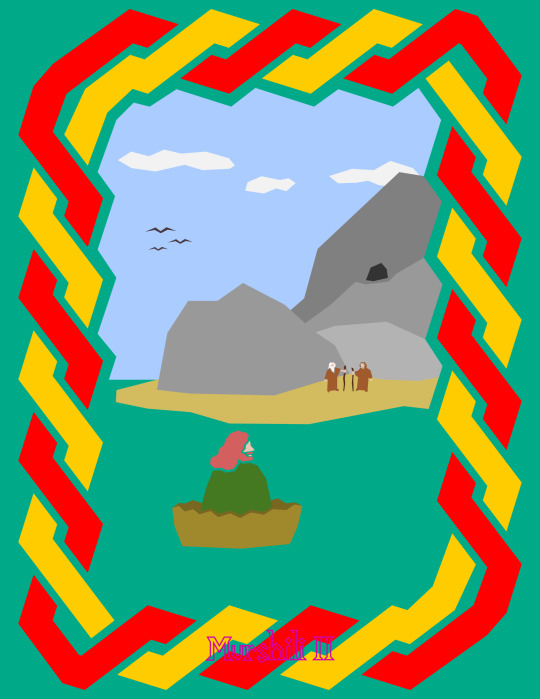
Tynwald Day Special: Maughold of Man
~ ~
Our sixth Celtic Month piece celebrates Tynwald Day, the national day of the Isle of Man, which is on July 5th. Remember to pet a Manx cat.
Before you read what the piece means to me, share what it means to _you_. I’m just the artist; you’re the beholder.
Leave a comment.
~ ~
The Isle of Man, also sometimes spelled Mann, is a little Gaelic nation in the Irish Sea; the Manx language is closely related to Irish and Scottish Gaelic. The language became extinct with the death of its last native speaker in 1974; but revival is in progress, and many people have learned the language since that time with the help of the materials he left behind.
I know of no better Manx story than the origin of Man’s patron saint, St. Maughold of Man; called, in Latin, Maccaldus.
According to the tale, Maughold was a young Irish prince and leader of a gang of ne’er-do-wells during the time when St. Patrick was teaching Christianity in Ireland. One time, he and his companions tried to make a fool of St. Patrick by putting a live man under a shroud and begging St. Patrick to revive him. St. Patrick came and placed his hand on the man, but nothing happened; and after he went away, they discovered that the man under the shroud was dead.
They caught up to St. Patrick, apologized to him, and begged him to come back and revive the man for real; which St. Patrick did, and the man was risen back to life.
After that, the youths all asked to be baptized as Christians; and after baptizing them, St. Patrick admonished Maughold for leading his followers into ill deeds. To make things right, St. Patrick told him he must set to sea in a tiny wicker-boat (a coracle, scarcely larger than its occupant), without any oars, and abandon himself to the will of God.
Maughold did so; and he was conducted safely to the shores of Man; they say, at the place that became known as Maughold Head. He lived in a cave for many years, and went on to become the successor to Romuil and Conindri (in Latin, Romulus and Conindrus), the disciples Patrick had previously sent to teach Christianity to the Manx people.
#tynwald_day#isle_of_man#isle_of_mann#manx#maughold#celts#celtic#spring#springholidays#digitalart#vector#mosaic#collage#inkscape
2 notes
·
View notes
Text
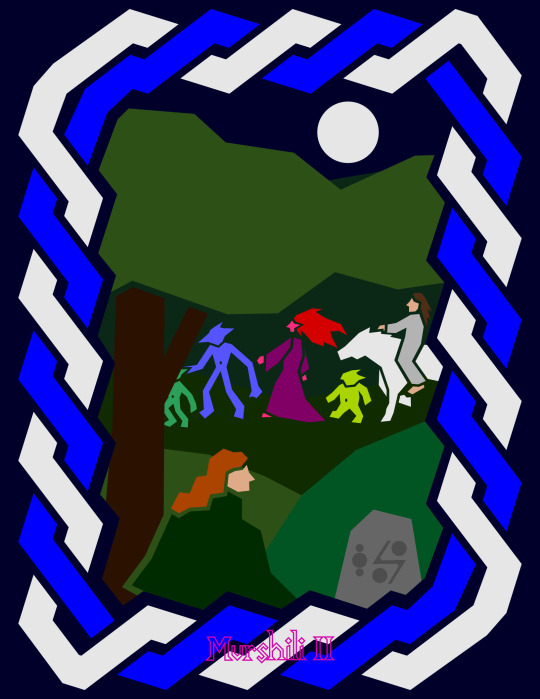
St. Andrew’s Day Special: Tam Lin
~ ~
Our fifth Celtic Month piece celebrates St. Andrew’s Day, the national day of (among other nations) Scotland, which is on November 20th. Scotland just had to ruin the spring theme the Celtic holidays had going, with their late autumn festival. It’s never the wrong time of year to wear a kilt, though; and it is _always_ the wrong time of year to play the bagpipes.
(Pssst, today is Nowruz; go back and look at my Nowruz Special.)
Before you read what the piece means to me, share what it means to _you_. I’m just the artist; you’re the beholder.
Leave a comment.
~ ~
I had some difficulty choosing a distinctively Scottish legend to portray; because the Scots are an Irish people, and they share their entire ancestral mythology with the Irish.
I ultimately chose a tale of relatively recent origin, exclusive to Scotland: the tale of Tam Lin.
It used to be said that a mysterious figure roamed the forest of Carterhaugh, by the name of Tam Lin; and one autumn night, Janet (or in some tellings Margaret), the daughter of the landowner, decided to find out for herself.
After an encounter with the dashing spectre, she learns that he is not himself a fairy, but a human taken by the fairies long ago; and he fears that during the upcoming Samhain procession, he may be made the tithe to which they owe the Devil.
He tells Janet she can rescue him if she does exactly as he instructs; and on Samhain Night, she lies in wait under a green cloak at the place where the procession will pass. She waits for the Queen of the Fairies, and then Tam Lin, on a white horse, to draw near; and then she snatches him from the saddle.
The Fairy Queen causes him to transform into many fearful shapes, including (by various tellings) a lizard, a snake, a lion, a swan, a burning brand, and a red-hot piece of iron; but Janet knows none of these illusions can harm her; and she holds fast onto him until he turns human again.
Her tricks exhausted, the Fairy Queen lets him be; and she laments that she should have turned his eyes to stone before he ever saw Janet.
Janet and Tam Lin go on to be married, and live happily ever after.
The stone in the foreground is marked with two common Pictish symbols often found on Pictish monoliths: the Triple Disc, and the Double Disc and Z-Rod. The Picts were the mysterious ancient people who lived in northern Britain before the Scots arrived from Ireland. They were later replaced and absorbed by the Scots. They left little writing. Very little is known about them. They were probably Celts of some kind; but we may never know for sure.
#st_andrews_day#scotland#scots#scottish#picts#pictish#tam_lin#fairies#celts#celtic#spring#springholidays#digitalart#vector#mosaic#collage#inkscape
1 note
·
View note
Text
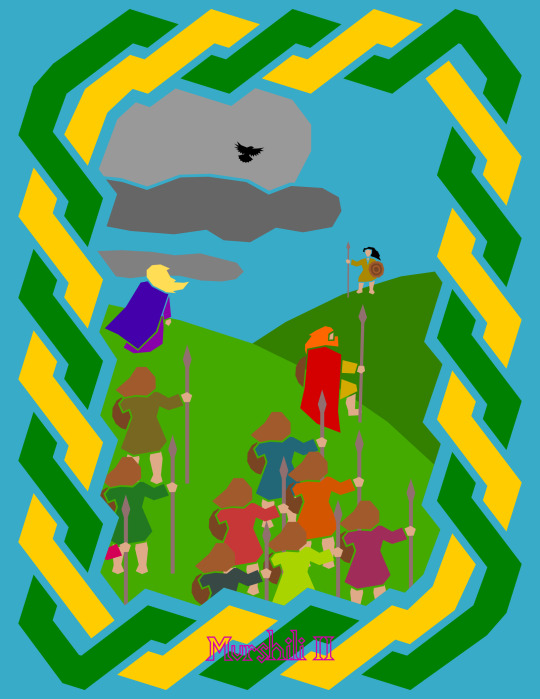
St. Patrick’s Day Special: The Defender of Ulster
~ ~
Our fourth Celtic Month piece celebrates St. Patrick’s Day, the national (and international) day of Ireland, on March 17th. Eat some boiled food; play the bodhrán; fight the English; but better yet, study the Irish language. I _promise_ the orthography is less intimidating than it looks.
Before you read what the piece means to me, share what it means to _you_. I’m just the artist; you’re the beholder.
Leave a comment.
~ ~
Irish legend is replete with good stories and epic tales; but I ultimately decided to portray a key moment from the Táin Bó Cúailnge, featuring Cú Chulainn, one of Ireland’s most famous heroes.
In ancient Ireland, Queen Medb (or Maeve) and King Ailill of Connacht realized that they were equal in property except for one thing, namely Ailill’s bull, Finnbhennach, to whom there was only one equal in all of Ireland: Donn Cúailnge, a bull owned by an Ulsterman.
This may sound like a trivial issue; but within the context of ancient Irish society, unequal property in marriage was a very big deal; because Brehon Law, the code which governed Irish society before foreign law was imposed, acknowledged many types of marriages, some of them distinguished by the ratio of the property that the respective parties brought to the marriage. A marriage between a wealthier husband and a poorer wife was a substantially different legal relation than a marriage between an equally wealthy husband and wife.
After negotiations failed (due to a drunken envoy), Queen Medb resolved to attack Ulster and steal the bull; and so the Táin Bó Cúailnge (“Cattle Raid of Cooley”) began. Raising an enormous army and recruiting Fergus mac Róich, an exiled Ulsterman, as a general, Queen Medb and King Ailill advanced upon Ulster.
As a result of an earlier incident, the men of Ulster bore a curse that at their moment of need, they would all suffer labor-pains; and only one warrior was able to stand in Ulster’s defense: Cú Chulainn, a heroic youth, not yet having reached manhood.
Originally named Sétanta, he became known as Cú Chulainn, “Hound of Culann”, after he killed the enormous guard-dog of a man named Culann in self-defense, and agreed to guard Culann’s house until one of the dog’s puppies could be raised to an equally enormous size.
Along with his brother-in-arms Ferdiad, he was trained in the art of battle by the renowned Scottish warrior Scáthach. A precocious student, he defeated her sister Aífe in single combat at that young age, ending a long-ongoing feud that his teacher had been unable to resolve herself.
Thus, as the only beardless youth capable of holding his own in combat, Cú Chulainn stood alone against the armies of Connacht; holding them off at river passes, and invoking single combat to take on their forces one by one; buying time for the men of Ulster to recover from their curse.
In the course of this defense, he had to fight his old friend Ferdiad to the death; and killed him using the Gáe Bulg spear, the one thing Scáthach taught him that she didn’t also teach Ferdiad.
Cú Chulainn could only be defeated after he had broken his “geas” (pronounced “gyas”); a taboo, prophecy, or imperative, upon which one’s power is contingent, which both predicts and brings doom. Cú Chulainn had a geas that his downfall would come if he ever ate dog-meat.
This would come to pass after the Mórrígan, fickle crow-goddess of war and death, in the form of an old crone, offered him dog-meat, which he was obliged by courtesy to accept; ensuring his ruin in repayment of a grudge.
Thus at the hands of the Connacht warriors would come the end of Cú Chulainn’s short, tragic, glorious life.
The golden-haired figure is Queen Medb; the red-haired bearded figure beside her is either King Ailill, or Fergus. Fergus was given the task of leading Medb’s contingent on the battlefield, according to the epic; so we could either be looking at Queen Medb and Fergus at the head of her contingent, or both contingents with the king and queen at their respective heads.
Across, we see the beardless youth, Cú Chulainn, prepared to stand alone against them.
The valley between the foreground-hill and the background-hill plausibly contains a river and a ford, where Cú Chulainn will make one of his one-man stands to single-handedly hold the forces of Connacht at bay.
The crow and the stormclouds at upper left, of course, represent the Mórrígan and the bloodshed to come. I portrayed each of the warriors as bearing a spear and a shield; because the Irish word for “warrior”, “gaiscíoch”, comes from the words “ga” and “sciath”, “spear” and “shield”. I based the shields on the Kiltubbrid Shield, an ancient alder-wood shield found in a bog in County Leitrim.
#st_patricks_day#ireland#irish#cuchulainn#cu_chulainn#medb#maeve#morrigan#celts#celtic#spring#springholidays#digitalart#vector#mosaic#collage#inkscape
0 notes
Text
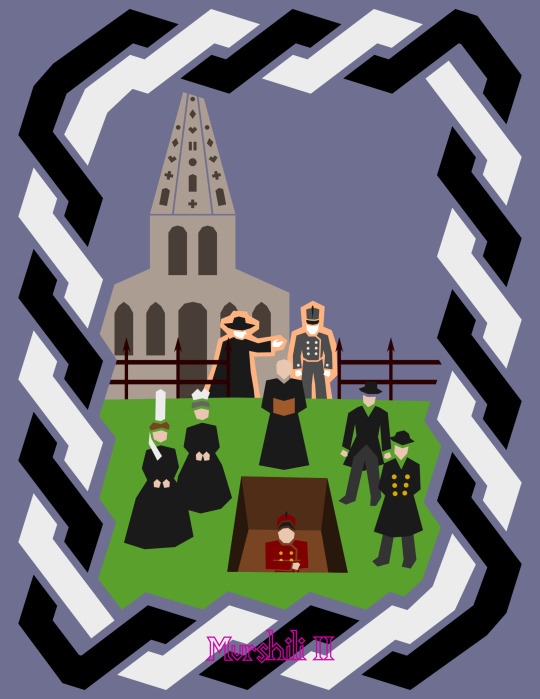
St. Yves’ Day Special: The Ankou
~ ~
Our third Celtic Month piece celebrates St. Yves’ Day, the national day of Brittany; which is on May 19th. Remember to sing some Breton folk songs.
Before you read what the piece means to me, share what it means to _you_. I’m just the artist; you’re the beholder.
Leave a comment.
~ ~
The Bretons dwell in Brittany, a peninsula of France; and both the people and their homeland derive their name from their origin as Britons who fled from Britain to the mainland during the Anglo-Saxon invasion. They are the only Celts who live in mainland Europe, at present; but they came from the Isles. The Breton language is closely related to Welsh and even more closely related to Cornish.
In Breton folklore, the Ankou is said to be an assistant to Death; a figure in a black cloak and hat who collects the souls of the dead and guides them into the afterlife.
Many tales are told about his origins. Some say he was the first child of Adam and Eve, and the first human being to die. Others say he was a prince who challenged Death, and lost.
Others say, and this is the notion I prefer, that the Ankou is the last, or first, person to die in each parish each year; responsible for guiding souls for one year until another takes their place. That way, the dead are greeted by a familiar personage when it’s time to make their final journey.
There are equivalent legends in Cornwall and Wales; the Cornish term is Ankow, and the Welsh term is Angau. There are comparable legends elsewhere. According to a Scottish legend, the last person buried in a graveyard is responsible for guarding it until the next burial. In parts of England there are legends that the first person buried in a graveyard will be responsible for guarding it; and customarily, a dog is buried first, to become the graveyard’s church-grim (a well and truly good boy).
The soldier in the grave, whose soul is being beckoned by the Ankou, as well as the priest performing the funeral liturgy, are a homage to one of my favorite Breton folk songs, Ar Soudarded (Zo Gwisket e Ruz). The chorus-verse means “The soldiers dress in red; the priests dress in black.” It’s a melancholy song about a soldier who speaks of his burial if he should die.
I chose to depict the dead spectres in monochrome; and I’m not sure it was an effective choice. I found it necessary to add the luminous peach-colored halos to clarify the intended effect.
The steeple in the background is inspired by the distinctive cutout designs in the steeple of Tréguier Cathedral.
St. Yves of Kermartin, also called St. Yves Hélory, whose name is also spelled all sorts of other ways such as Ives, Ivo, Erwan, Iwan, Youenn, and Eozenn, and who is not to be confused with St. Yves of Chartres, St. Erbin of Dumnonia, or anyone with the surname Saint-Yves, was a pious clergyman and lawyer who was known for representing the poor and vulnerable, refusing bribes, and unraveling the tricks of swindlers. Every year on his feast day, May 19th, Catholic lawyers from around the world gather at his major shrine at Tréguier Cathedral to pay pilgrimage. Tréguier is also one of the seven sites of the Tour of Brittany, although not because of St. Yves.
The two women mourning at the burial are wearing distinctive traditional stovepipe bonnets, a notable feature of Breton dress.
#st_yves_day#st_yves#brittany#breton#treguier#ankou#death#celts#celtic#spring#springholidays#digitalart#vector#mosaic#collage#inkscape
8 notes
·
View notes
Text
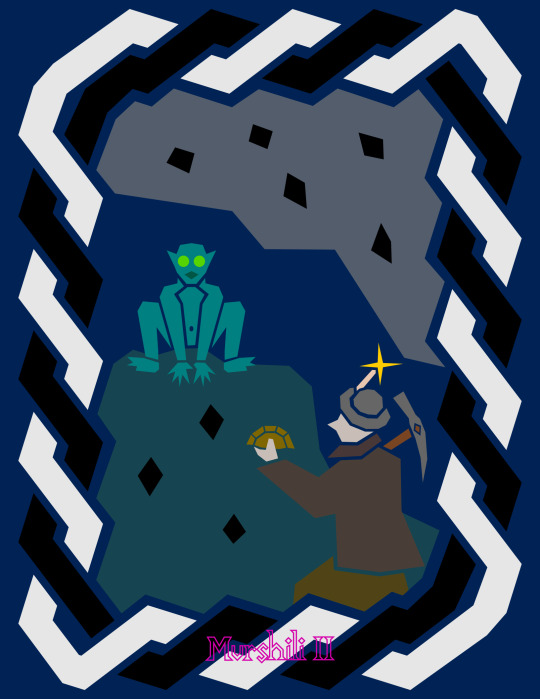
St. Piran’s Day Special: The Tommyknocker
~ ~
Our second Celtic Month piece celebrates St. Piran’s Day, on March 5th, the national day of Cornwall. Have some pasties! Mine some tin! Talk like a stereotypical movie pirate; but not if anybody Cornish can hear you.
Before you read what the piece means to me, share what it means to _you_. I’m just the artist; you’re the beholder.
Leave a comment.
~ ~
This was actually the first Spring Vignettes piece I created; and I think it remains the best, for its elegant minimalism and flawless composition.
I said in the last description that the Welsh are the survivors of the Celtic Britons; but they aren’t the only ones; because the Cornish still remain. The Cornish language went extinct in the 18th or 19th Century, but it’s currently being revived. Long may the Cornish language and people endure.
Cornwall is known for its tin-mining. During the Bronze Age, tin was one of the two ingredients of that era’s eponymous metal; and while copper could be found around the Mediterranean, traders needed to import tin from far afield to supply the great empires of the Near East. Cornwall has likely been one of those sources since very ancient times.
According to legend, St. Piran, patron saint of Cornwall and tin-miners, rediscovered tin-smelting when his black hearthstone put forth a pool of liquid metal that formed the shape of a cross. To this day, the flag of Cornwall is a silver cross on a black field.
Tin occurs in the form of a pitch-black ore, cassiterite, which forms distinctive rhombic crystals.
Cornish miners tell of a subterranean fairy-being, called a knocker or tommyknocker, that inhabits the deep and guards its precious ore. Provided they’re on friendly terms, tommyknockers can protect miners, lead them to veins of ore, and warn of collapses by knocking on the walls. On the other hand, if disrespected, they can steal tools, extinguish lights, or even collapse mines. It’s customary to toss the last bite of your pasty to the tommyknockers, to keep their good favor.
Cornish pasties, a savory hand-pie, are a cherished part of Cornish cuisine; usually filled with beef, potato, rutabaga, and lots of pepper. The parameters of an authentic Cornish pasty are heavily regulated by the Cornish Pasty Association. If you ever find carrots in a Cornish pasty, it is generally agreed that you should throw it back in the face of whoever gave you it; because carrots have no place in a Cornish pasty. They’re a savory food, and carrots are too sweet. If you find a pasty containing anything sweeter than carrots, you should probably stomp on it.
Fun fact: The style of speech now popularly associated with pirates is by origin a highly stylized version of a Cornish accent. Those in Cornwall who don’t delve in the mines likely sail on the sea; and the accent was well at home among salty sailors with many yarns to tell during the Age of Sail. Many rounds of iterated exaggeration eventually produced the absurd caricature recognizable throughout the English-speaking world today. Cornish English is rhotic, which is to say, R is pronounced even when it is not before a vowel; and while this feature is common in North American English, it stands out among the other dialects spoken in Southern England. I wouldn’t wonder if this was the reason for the greatly exaggerated Rs in the stylized imitations.
The interjection “arr” is actually known to be used in Cornwall, where it is synonymous with “aye”, “yea”, and “yes”.
#st_pirans_day#cornwall#cornish#knocker#tommyknocker#tin#mine#miner#cave#celts#celtic#spring#springholidays#digitalart#vector#mosaic#collage#inkscape
1 note
·
View note
Text
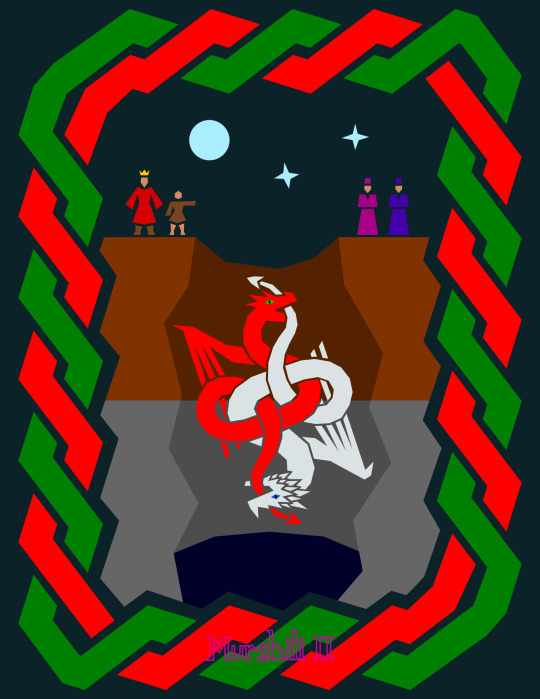
St. David’s Day Special: The Dragon Prophecy
~ ~
Welcome to Celtic Month! For the entire month of March, the Spring Vignettes series will be dedicated entirely to Celtic homage vignettes. Non-Celtic pieces will resume in April.
Quick clarification: It’s pronounced Keltic, unless it’s a sports team; and even then, any linguists in the room will cringe if you pronounce it Seltic.
Our first Celtic Month piece celebrates St. David’s Day, on March 1st, the national day of Wales. Have some cheese toast! Pet a dragon! Kiss a Welshman, if you can find one.
Before you read what the piece means to me, share what it means to _you_. I’m just the artist; you’re the beholder.
Leave a comment.
~ ~
The Welsh are the survivors of the Celtic Britons, who were the inhabitants of all southern Britain before the Angles, Saxons, and Jutes invaded and established what became England. “Welsh” is an Anglo-Saxon term; it means “other people” or “foreigners”, which is ironic, considering the Germanic-speaking peoples were the foreigners in the native lands of the Britons.
There is certainly no more famous Welshman than King Arthur Pendragon, a legendary king of yore who supposedly ruled Britain between the retreat of the Romans and the invasion of the Saxons. His legend, much-developed over the centuries, became well-known throughout Europe in later times.
A notable legend tells of the building of Dinas Emrys, a castle on a hill by the Glaslyn river. By some accounts, it was built by Uther Pendragon, father of King Arthur; by other accounts, it was Vortigern, the same foolish king of the Britons who later invited the Saxons into Britain as mercenaries to defend the Britons from the Picts.
After the king had chosen the hill on which the castle would stand, his builders went to work; but every day, they built up the walls, only for them to topple overnight. No progress could be made. At length, the king asked his wisemen to find the cause and the solution to the problem.
His wisemen told him that for the building to succeed, a sacrifice would be necessary; and the sacrifice must be a boy not sired by mortal man. Such a boy existed; a young boy named Merlin, or Ambrosius, the baptized son of a devil, who would go on to be known for his abilities in the magic arts.
(Foundation sacrifices were once an incredibly widespread custom; we know from archaeological evidence that the burying of a human victim under the foundation of an important building was practiced in ancient Ireland. Similar legends are told in Romania, Greece, Japan, and elsewhere. Animals were later buried under foundations after human sacrifices ceased.)
The boy was brought to the hill; and the king’s wisemen told the king to sacrifice him to appease the heathen gods so that the castle could be build. But the boy laughed at their advice, and told the king he knew much better. He told the king that if a hole were dug, there would be found a deep, dark pool; and in that pool, there would be found two dragons, one red, one white; and it was the fighting of these dragons that shook the hill each night and made the walls collapse. The king had a deep hole dug; and indeed, there was found a deep, dark pool; and from that pool indeed emerged two dragons, one red, one white.
Freed from their imprisonment, the dragons fought viciously, until, despite being the lesser of the dragons, the red dragon defeated the white dragon, and drove it out of the land across the sea.
The boy then prophesied that, just as the red dragon triumphed over the white dragon, so the Britons would triumph over the invading Saxons.
And they did; until the death of King Arthur at the hands of his son Mordred, whereafter, the Saxons finally defeated the Britons, and drove them into the western mountains.
The great Welsh sagas, the Mabinogion, tell about how the two dragons originally became trapped under the site of Dinas Emrys, when an ancient Welsh king intoxicated them with a cauldron of ale and buried them to silence their deafening shrieking.
#st_davids_day#wales#welsh#dragons#uther#vortigern#merlin#dinas_emrys#arthurian#celts#celtic#spring#springholidays#digitalart#vector#mosaic#collage#inkscape
48 notes
·
View notes